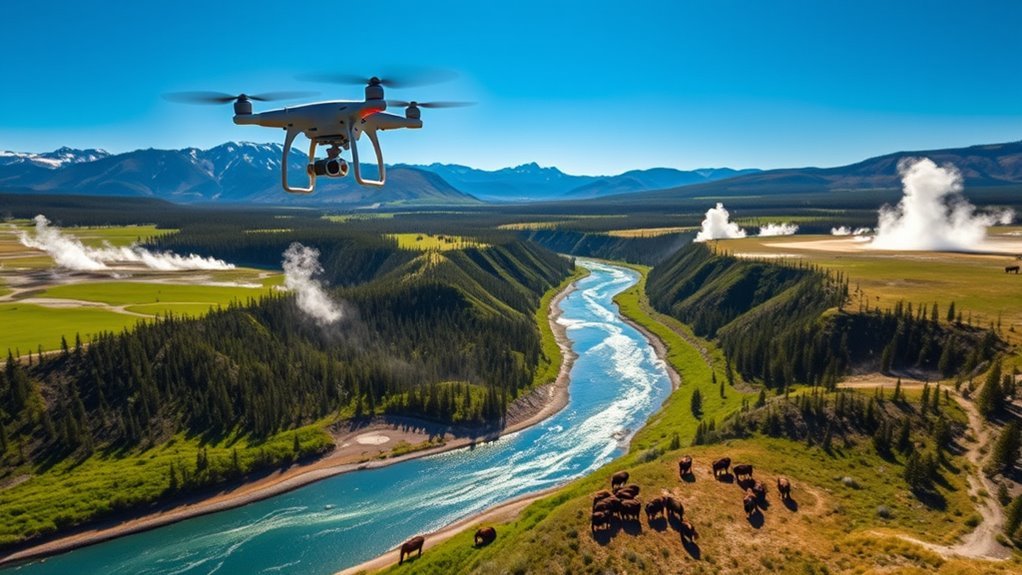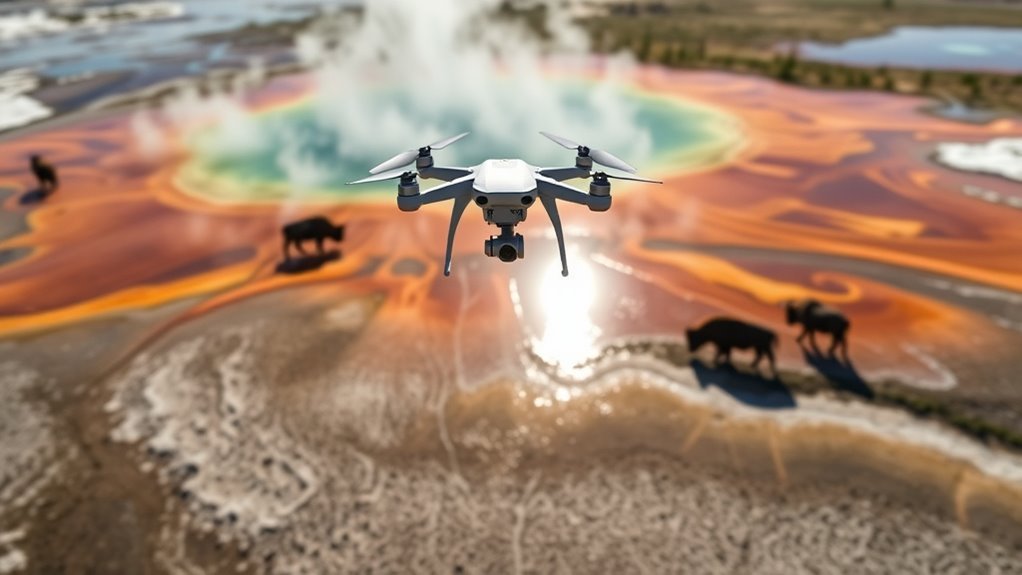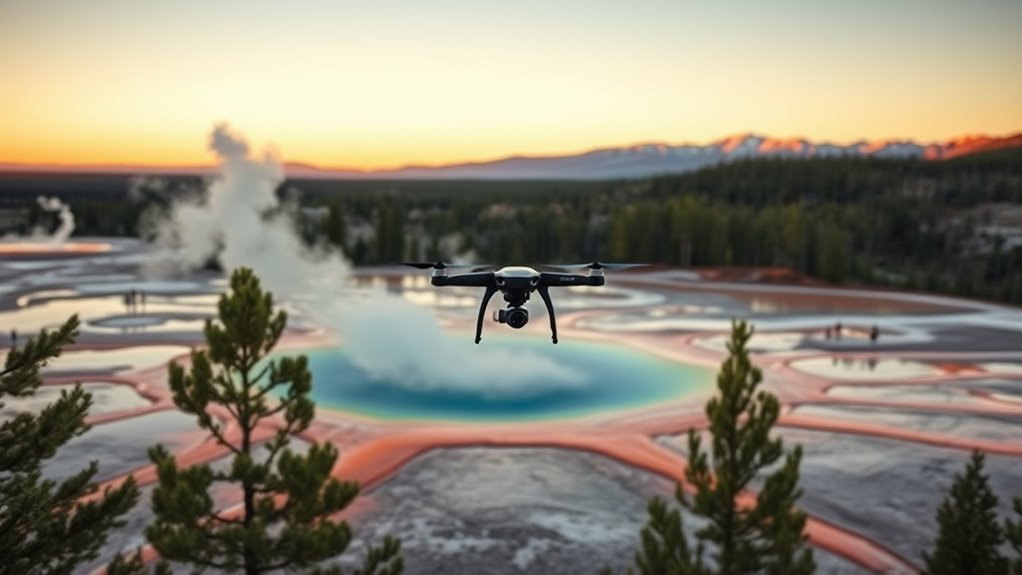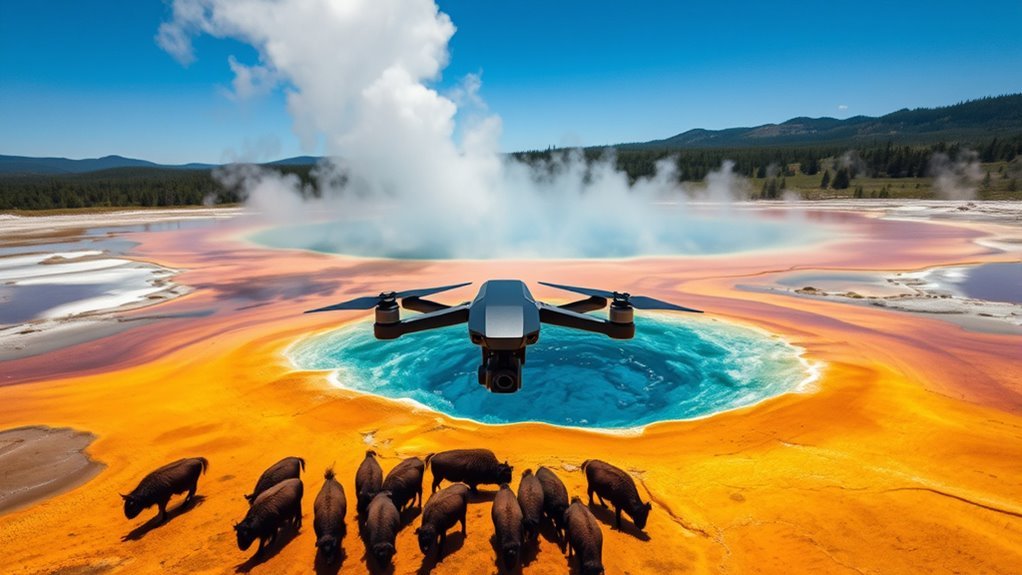To safely use drones for photography in Yellowstone National Park, you need to follow specific regulations. Drones require a special permit, and flying is prohibited in crowded areas and near wildlife. Always check for permitted zones before launching your drone, and keep it within sight. Being mindful of the impact on the environment and wildlife is vital. Stick around to uncover more about essential drone models and tips for capturing stunning aerial shots in the park.
Overview of Drone Regulations in National Parks

When you’re planning to capture breathtaking aerial shots in national parks, it’s essential to understand the drone regulations that govern these areas. Many national parks prohibit drone use entirely due to concerns over wildlife disturbance and visitor safety. Embracing drone technology can enhance your photography, but you must respect these regulations to promote photography ethics and preserve nature. Always check specific park guidelines before you take off; ignorance isn’t an excuse. Consider alternative locations or times that allow drone flying. By adhering to these rules, you’re ensuring that everyone can enjoy the beauty of the parks without disruption. Remember, your freedom to explore should coexist with responsibility towards nature and fellow visitors. Additionally, fines for non-compliance can be imposed if you violate restricted zones, so it’s crucial to stay informed. Choose wisely, and your aerial adventures can be both legal and ethical.
Specific Rules for Drones in Yellowstone

In Yellowstone National Park, drone regulations are particularly strict, reflecting the park’s commitment to preserving its unique ecosystems and ensuring visitor safety. You can’t fly drones in the park without a special permit, as unauthorized use can disrupt wildlife and other visitors. Drone technology offers amazing photography opportunities, but with that comes a responsibility to follow photography ethics. Respect the natural environment, and avoid flying over animals or sensitive areas. It’s essential to remember that your freedom to explore should never compromise the park’s integrity. Always check for the latest rules before your visit, and consider how your actions impact both the landscape and those who share this breathtaking space. By adhering to these guidelines, you help protect Yellowstone for generations to come.
Permitted Areas for Drone Use

When planning your drone photography in Yellowstone, it’s essential to know where you can legally fly. There are specific areas designated for drone use, along with strict regulations to protect wildlife and the park’s natural beauty. Understanding these permitted zones will help you capture stunning images while respecting the park’s rules.
National Park Regulations
Although you might be enthusiastic to capture breathtaking aerial shots in Yellowstone, it’s essential to understand that flying drones is heavily regulated within national parks. To enjoy your photography while respecting the environment and wildlife, keep these key regulations in mind:
- Drones are generally prohibited in all national parks, including Yellowstone.
- Respect wildlife and their habitats; drone disturbances can harm animals.
- Consider photography ethics by prioritizing natural beauty over disruptive technology.
- Stay updated on drone technology rules, as regulations may change.
Designated Drone Zones
While most areas in Yellowstone prohibit drone use, there are specific designated drone zones that allow you to safely capture stunning aerial photography without violating regulations. These zones are strategically located to guarantee you can explore the park’s beauty while adhering to drone safety guidelines. Before you take off, familiarize yourself with the allowed areas to maximize your experience. Utilizing effective photography techniques in these zones can yield breathtaking shots of the park’s diverse landscapes. Remember, respecting the environment and wildlife is vital, so always keep your drone within the designated limits. By doing so, you not only protect Yellowstone’s natural beauty but also enjoy the freedom of capturing it from above with your drone.
Restricted Wildlife Areas
In addition to designated drone zones, there are specific restricted wildlife areas within Yellowstone where drone use may be permitted under certain conditions. To guarantee you respect wildlife habitats and minimize drone interactions, keep these guidelines in mind:
- Observe distance restrictions: Maintain a safe distance from all wildlife to avoid stress or disruption.
- Check for seasonal regulations: Some areas may have specific times when drone use is restricted to protect sensitive wildlife during breeding seasons.
- Limit flight times: Early mornings or late evenings are preferable for less wildlife disruption.
- Report any disturbances: If your drone inadvertently impacts wildlife, notify park officials immediately.
Prohibited Activities While Flying Drones
When flying drones in Yellowstone, it’s essential to understand the prohibited activities that could lead to serious consequences. You’ll need to adhere to national park regulations, avoid disturbing wildlife, and stay clear of restricted airspace. Ignoring these rules not only jeopardizes your photography experience but also threatens the park’s natural beauty and safety.
National Park Regulations
Though you might be enthusiastic to capture stunning aerial shots, it’s essential to understand that flying drones in Yellowstone National Park comes with strict regulations designed to protect both wildlife and the natural environment. To guarantee you’re compliant and respectful, keep these prohibitions in mind:
- Don’t fly drones over crowds or congested areas.
- Avoid capturing images that could disrupt the park’s serene atmosphere.
- Refrain from flying near wildlife or sensitive habitats.
- Never use drone technology to interfere with other visitors’ experiences.
Wildlife Disturbance Restrictions
While you might be enthusiastic to get that perfect shot of Yellowstone’s breathtaking landscapes, it’s crucial to remember that flying drones can greatly disturb the park’s wildlife. Approaching animals with your drone can alter their natural behavior, causing stress and disruption. To promote drone safety and protect the wildlife, avoid flying near active nests, mating grounds, or areas where animals are known to congregate. Respecting these wildlife disturbance restrictions not only helps maintain the park’s ecological balance but also allows you to enjoy the experience without negatively impacting the animals. Remember, your freedom to explore comes with the responsibility to safeguard Yellowstone’s natural inhabitants. Prioritize their wellbeing while capturing your stunning aerial shots.
Airspace Limitations
Respecting wildlife is just one aspect of responsible drone use in Yellowstone. You need to be aware of airspace restrictions and altitude limits that guarantee everyone’s safety and enjoyment of the park. Here are some prohibited activities while flying drones:
- Flying above 400 feet: Stay within altitude limits to avoid interference with manned aircraft.
- Operating in restricted zones: Areas like visitor centers and wildlife habitats are off-limits.
- Disrupting park operations: Don’t fly near rescue missions or ongoing park activities.
- Ignoring weather conditions: Flying in poor visibility can lead to dangerous situations.
Safety Considerations When Using Drones
As you prepare to capture stunning landscapes in Yellowstone, it’s crucial to prioritize safety when using drones. Start by familiarizing yourself with drone safety guidelines specific to the park. Always keep your drone within sight and avoid crowded areas to minimize risks. Before takeoff, check the weather and verify your battery is fully charged. Implement emergency procedures, like understanding how to regain control in case of a malfunction. Be ready to land your drone safely if conditions change unexpectedly. Remember, your freedom to fly comes with the responsibility to respect others and the environment. By prioritizing safety, you’ll enjoy a fulfilling photography experience while protecting the beauty of Yellowstone for everyone.
Impact of Drones on Wildlife and Environment
Using drones for photography in Yellowstone can create breathtaking visuals, but it’s important to contemplate their impact on wildlife and the environment. Before you take to the skies, consider these factors:
- Wildlife Disturbance: Drones can frighten animals, disrupting their natural behavior and mating rituals.
- Environmental Impact: The noise and presence of drones can alter habitats and affect ecosystems.
- Stress on Species: Frequent drone use may lead to stress for sensitive species, impacting their health and survival.
- Regulatory Compliance: Always adhere to park regulations to protect both wildlife and the stunning landscapes you wish to capture.
Recommended Drone Models for Aerial Photography
When it comes to capturing stunning aerial shots in Yellowstone, selecting the right drone can make all the difference. Look for models like the DJI Mavic Air 2 or the Autel Robotics EVO Lite, which boast impressive drone features such as obstacle avoidance and long flight times. The camera quality on these drones is exceptional, with 4K video capabilities and high-resolution stills that truly showcase Yellowstone’s beauty. Additionally, consider the DJI Mini 2 for its lightweight design and user-friendly interface, perfect for beginners. The Autel EVO Lite+ V2 excels in low-light conditions, making it an excellent choice for capturing Yellowstone’s landscapes during twilight. Moreover, drones like the DJI Air 3 offer dual camera systems that enhance versatility for photographers. Whatever model you choose, verify it aligns with your photography goals while adhering to park regulations. With the right drone, you’ll be well-equipped to explore the skies and capture breathtaking images of this incredible landscape.
Tips for Capturing Stunning Aerial Shots
To capture stunning aerial shots in Yellowstone, it’s essential to plan your shots carefully and consider the unique landscape. Here are some tips to enhance your aerial composition while ensuring drone stability:
- Scout Locations: Visit potential shooting spots beforehand to identify the best angles and lighting conditions. Additionally, consider the battery life of your drone to ensure you have enough power for your flight.
- Use the Rule of Thirds: Position key elements along the grid lines to create a balanced composition.
- Maintain Drone Stability: Utilize features like GPS and altitude hold to keep your drone steady for sharp images.
- Experiment with Altitude: Fly at different heights to discover the most enthralling perspectives of the breathtaking scenery. Additionally, maintaining drone stability is crucial as environmental exposure can affect performance and durability.
Consequences of Violating Drone Regulations
Capturing breathtaking aerial shots in Yellowstone may seem enticing, but it’s essential to understand the local drone regulations. Ignoring these rules can lead to serious consequences. You could face legal repercussions, including fines and possible criminal charges. The National Park Service takes drone violations seriously, and you might find yourself banned from the park altogether. Financial penalties can range considerably, with some fines reaching thousands of dollars, depending on the severity of the violation. Besides the monetary consequences, violating these regulations can also harm wildlife and disrupt the park experience for others. Additionally, strict adherence to designated areas is critical to avoid unauthorized flights that could result in significant penalties. So, while the freedom to fly your drone is appealing, it’s crucial to respect the rules to protect both the park and your wallet.
Frequently Asked Questions
Can I Fly My Drone in Winter at Yellowstone?
You can’t fly your drone in Yellowstone during winter, as drone regulations prohibit it year-round. For stunning winter photography, consider other methods that respect the park’s wildlife and preserve its natural beauty.
Are There Any Altitude Limits for Drone Flights in Yellowstone?
Drones definitely demand diligence. You’ll need to adhere to drone regulations, ensuring you don’t disturb wildlife or exceed altitude limits. Respecting these rules fosters freedom for everyone to enjoy Yellowstone’s breathtaking beauty without disruption.
What Are the Best Times to Fly Drones in Yellowstone?
The best seasons to fly drones in Yellowstone are spring and fall. Consider wildlife migrations and breeding patterns; early morning or late afternoon flights minimize disturbances, ensuring you capture stunning visuals while respecting nature’s rhythms.
Do I Need a Special Permit to Fly a Drone in Yellowstone?
Yes, you’ll need a special permit to fly a drone in Yellowstone. It’s essential to follow drone regulations and photography guidelines to guarantee a safe experience while respecting the park’s natural beauty and wildlife.
How Can I Report Drone Violations in Yellowstone?
If you witness drone violations in Yellowstone, you can report them through the National Park Service’s reporting process. Familiarize yourself with drone regulations to provide accurate details and help protect the park’s natural beauty.

